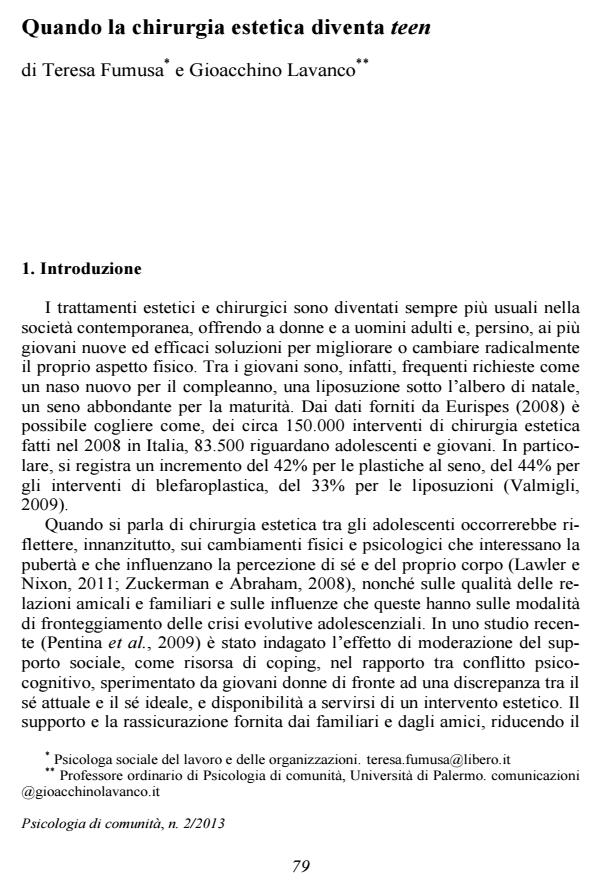Quando la chirurgia estetica diventa teen
Titolo Rivista PSICOLOGIA DI COMUNITA’
Autori/Curatori Teresa Fumusa, Gioacchino Lavanco
Anno di pubblicazione 2014 Fascicolo 2013/2 Lingua Italiano
Numero pagine 12 P. 79-90 Dimensione file 59 KB
DOI 10.3280/PSC2013-002010
Il DOI è il codice a barre della proprietà intellettuale: per saperne di più
clicca qui
Qui sotto puoi vedere in anteprima la prima pagina di questo articolo.
Se questo articolo ti interessa, lo puoi acquistare (e scaricare in formato pdf) seguendo le facili indicazioni per acquistare il download credit. Acquista Download Credits per scaricare questo Articolo in formato PDF

FrancoAngeli è membro della Publishers International Linking Association, Inc (PILA)associazione indipendente e non profit per facilitare (attraverso i servizi tecnologici implementati da CrossRef.org) l’accesso degli studiosi ai contenuti digitali nelle pubblicazioni professionali e scientifiche
La ricerca si pone l’obiettivo di indagare alcune variabili psicosociali ritenute dalla letteratura sull’argomento elementi importanti dell’interesse per la chirurgia estetica, come la percezione corporea e l’Ego-resiliency, in un gruppo di 210 adolescenti e giovani donne del territorio palermitano. I dati mostrano come la percezione di sé abbia un ruolo centrale, essendo l’unica variabile tra quelle indagate che influisce sull’interesse per la chirurgia estetica. Inoltre, l’Ego-resiliency, ossia la capacità di gestire in modo flessibile i propri impulsi e le proprie emozioni e di adattarsi efficacemente alle richieste dell’ambiente, è fortemente legato alla percezione di sé, che, a sua volta, determina l’interesse per la chirurgia estetica.;
Keywords:Chirurgia estetica, percezione corporea, percezione di sé, Ego-resiliency.
- Brown A., Furnham A., Glanville L., Swami V. (2007). Factors that affect the likelihood of undergoing cosmetic surgery. Aesthetic Surgery Journal, 27: 501-508. DOI: 10.1016/j.asj.2007.06.00
- Block J., Kremen A., (1996). IQ and Ego-Resiliency: Conceptual and Empirical Connections and Separateness. Journal of Personality and Social Psychology, 70 (2): 349-361. DOI: 10.1037/0022-3514.70.2.34
- Caprara M., Steca P., De Leo G. (2003). La misura dell’Ego-resiliency. Ricerche di psicologia, 26 (2): 7-23.
- Crerand, C.E., Franklin, M.E., Sarwer, D.B. (2006). Body dysmorphic disorder and cosmetic surgery. Plastic and Reconstructive Surgery, 118 (7): 167-180. DOI: 10.1097/01.prs.0000242500.28431.2
- Davis D., Vernon M.L. (2002). Sculpting the body beautiful: Attachment style, neuroticism and use of cosmetic surgeries. Sex Roles, 47: 129-138.
- Davison T.E., McCabe M.P. (2006). Adolescent Body Image and Psychosocial Functioning. Journal of Social Psychology, 146 (1): 15-30. DOI: 10.3200/SOCP.146.1.15-3
- Delinsky S.S., (2005). Cosmetic surgery: A common and accepted form of selfimprovement?. Journal of Applied Social Psychology, 35: 2012-2028. DOI: 10.1111/j.1559-1816.2005.tb02207.
- Frederick A.D., Lever J., Peplau L.A. (2007). Interest in cosmetic surgery and body image: Views of men and women across the life span. Plastic and Reconstructive Surgery, 120 (5): 1407-1415. DOI: 10.1097/01.prs.0000279375.26157.6
- Grogan S. (2008). Body image: understanding body dissatisfaction in men, women and children. New York: Routledge.
- Henderson-King D., Brooks K.D. (2009). Materialism, sociocultural appearance messages, and paternal attitudes predict college women’s attitudes about cosmetic surgery. Psychology of Women Quarterly, 33: 133-142. DOI: 10.1111/j.1471-6402.2008.01480.
- Hilhorst M.T. (2002). Philosophical pitfalls in cosmetic surgery: a case of rhynoplasty during adolescence. Journal of Medical Ethics: Medical Humanities, 28: 61-65. DOI: 10.1136/mh.28.2.6
- Honigman R., Castle D.J. (2006). Aging and Cosmetic enhancement. Clinical Interventions in Aging, 1 (2): 115-119. DOI: 10.2147/ciia.2006.1.2.11
- Huey S.J., Weisz J.R. (1996). Ego-Control, Ego Resiliency and the Five – Factor Model as Predictors of Behavioral and Emotional Problems in Clinic-Referred Children and Adolescents. Journal of Abnormal Psychology, 106 (3): 404-415.
- DOI: 10.1037/0021-843X.106.3.404LawlerM.,NixonE.(2011).BodyDissatisfactionAmongAdolescentBoysandGirls:TheeffectsofBodyMass,PeerAppearanceCulturesandInternalizationofAppearanceIdeals.JournalYouthAdolescence,40:59-71.DOI:10.1007/s10964-009-9500-
- Lee L.W., Chen S.H., Yu C.C., Lo L.J., Lee S.R., Chen Y.R. (2007). Stigma, Body Image and Quality of Life in women Seeking Orthognastic Surgery. Plastic and Reconstructive Surgery, 1: 225-231. DOI: 10.1097/01.prs.0000264100.57630.c
- Markey C.N., Markey P.N. (2009). Correlates of young women’s interest in obtaining cosmetic surgery. Sex Roles, 61: 158-166. DOI: 10.1007/s11199-009-9625-
- Pearl A., Weston J. (2003). Attitudes of adolescents about cosmetic surgery. Annals of Plastic Surgery, 50: 628-630. DOI: 10.1097/01.SAP.0000054365.54173.9
- Pentina I., Taylor D.G., Voelker T.A. (2009). The roles of self-discrepancy and social support in young females’ decision to undergo cosmetic procedures. Journal of Consumer Behavior, 8: 149-165. DOI: 10.1002/cb.27
- Sarwer D.B., Cash T.F., Magee L., Williams E.F., Thompson J.K., Roehrig M. (2005). Female college students and cosmetic surgery: an investigation of experiences attitudes and body image. Plastic and Reconstructive Surgery, 115: 931-938. DOI: 10.1097/01.PRS.0000153204.37065.D
- Sarwer D.B., Pruzinsky T., Cash T.F., Goldwyn R.M., Persing J.A., Whitaker L.A. (eds) (2006). Psychological aspects of reconstructive and cosmetic plastic surgery: Clinical, empirical and ethical perspectives. Philadelphia: Lippincott Williams.
- Sarwer D.B., Wadden T.A., Pertschuk M.J., Whitaker L.A. (1998). The psychology of cosmetic surgery: a review and reconceptualization. Clinical Psychology Review, 18: 1-22.
- Swami V., Arteche A., Chamorro-Premuzic T., Furnham A., Stieger S., Haubner T., Voracek M. (2008). Looking good: Factors affecting the likelihood of having cosmetic surgery. European Journal of Plastic Surgery, 30: 211-218. DOI: 10.1007/s00238-007-0185-
- Thomson J.A., Knorr N.J., Edgerton M.T. (1978). Cosmetic surgery: the psychiatric perspectives. Psychosomatics, 19 (1): 7-11. DOI: 10.1016/S0033-3182(78)71029-
- Thompson J.K., Schroff H., Herbozo S., Cafri C., Rodriguez J., Rodriguez M. (2007). Relations among multiple peer influences, body dissatisfaction, eating disturbance, and self-esteem: A comparison of overage weight, at risk of overweight, and overweight adolescent girls. Journal of Paediatric Psychology, 32 (1): 24-29. DOI: 10.1093/jpepsy/jsl02
- Valmigli C. (2009). Generazione condannata alla bellezza. Testo disponibile al sito: http://www.eurispes.it
- Zuckerman D., Abraham A. (2008). Teenagers and Cosmetic Surgery: Focus on Breast Augmentation and Liposuction. Journal of Adolescent Health (in press). DOI: 10.1016/j.jadohealth.2008.04.01
Teresa Fumusa, Gioacchino Lavanco, Quando la chirurgia estetica diventa teen in "PSICOLOGIA DI COMUNITA’" 2/2013, pp 79-90, DOI: 10.3280/PSC2013-002010